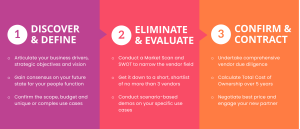Selecting the right HR technology can be a daunting task. And HR leaders are under pressure to find and implement solutions as swiftly and effectively as possible.
The traditional Request for Proposal (RFP) process, once a staple of HR tech evaluation, often leads to prolonged timelines, decision fatigue, and selections that may not align with the strategic vision of the organisation.
Pinpoint HRM addresses these issues head-on, offering a faster, more effective pathway to secure HR technology solutions that not only meets but propels organisations towards their strategic goals.
In this article we’ll explore Pinpoint’s approach to Accelerated HR Tech Evaluation. A streamlined, strategic approach designed to help you navigate the complexities of HR technology selection, ensuring a fit-for-purpose solution is identified and selected, every time.
The Imperative for Acceleration and Alignment
A study by Gartner revealed that 83% of HR leaders struggle to align their HR technology selections with business outcomes, underscoring the need for a focused, strategic approach to technology selection (Gartner, 2020).
The Pinpoint HRM 3-phased approach offers just that, enabling organisations to cut through the market noise, rapidly identify the right solutions, and achieve strategic alignment without the anguish typically associated with RFP processes.
1) Discover & Define: The Foundation for Success
Business Drivers & Strategic Priorities: Begin by articulating the ‘why’ behind your HR technology transformation. Is it to reduce administration, improve compliance, enhance the employee experience, drive growth, or increase operational agility? Perhaps it’s a mix of those and more. Understanding the strategic imperatives guides the selection process, ensuring technology investments deliver tangible business benefits. Ignoring this step can lead organisations to adopt solutions that, while technologically advanced, fail to address the unique challenges and opportunities facing the business.
- A study by PwC found that organisations that align HR technology with business strategy see a 26% higher revenue per employee.
Future State & Guiding Principles: Creating a vision of the desired future state of HR functions within your organisation is vital. Consider, for example, what operational efficiencies, employee experiences and strategic outcomes do you aspire to achieve? How sophisticated do your processes need to be? What level of maturity in recruitment, learning, performance, rostering do you want to achieve?
Defining this future state ensures that the HR technology roadmap is aligned with long-term business visions, avoiding short-term fixes that don’t scale or evolve with your organisation.
- A study by Josh Bersin Academy found that organisations with a clear, well-defined future state for their HR technology were 1.5 times more likely to report significant improvements in business outcomes compared to those without.
Evaluation Criteria: Establishing your evaluation criteria at this stage is crucial for a focused and effective selection process. This involves identifying what you want to be judging potential solutions on. Typical criteria include: ability to meet your scope with a minimum number of HR tech vendors, ability to address your most complex and unique use cases, cultural and organisational fit, value for money, ability to address your business objectives and strategic priorities, fit with guiding principles and scalability or integration flexibility.
- According to Gartner, 47% of HR leaders cite poor integration capabilities as the primary reason for HR technology failures, highlighting the need for clear evaluation criteria around reducing the number of vendors required to support your employee lifecycle along to ease integration and enable scale.
Without this foundational work in place, organisations risk selecting systems in isolation of a broader strategic agenda, leading to a lack of engagement in the project itself and low levels of user adoption after going live.
“Throughout the discovery and evaluation process the Pinpoint team were very approachable and helped us get clarity and alignment on our priority business outcomes while guiding us to find the best solution, which was no easy task! Finding a HR solution that took into account both the Institute’s complexity and our budget was the most valuable outcome from our engagement with Pinpoint.” Hilary Bolton, Deputy Director, Baker Heart & Diabetes Institute
2) Eliminate & Evaluate: Streamlining the Selection
Market Scan & SWOT Analysis: Conduct a comprehensive market scan to understand the landscape of potential solutions, evaluating each against a SWOT framework (Strengths, Weaknesses, Opportunities, Threats). This analysis ensures a match between the organisation’s needs and the vendor’s offerings, facilitating a targeted approach to solution selection. Typically, this requires tapping into the expertise on an external consultancy like Pinpoint to draw upon their extensive market knowledge and experience.
Shortlist: Narrowing down potential HR tech vendors to a select few (ideally 2-3) focuses the evaluation process and prevents documentation and decision fatigue. This refinement is critical for dedicating adequate time and resources to thoroughly assess each contender’s capability to meet your organisation’s unique requirements.
- Companies that effectively shortlist vendors based on predefined criteria are 60% more likely to achieve successful implementation within the projected timeframe and budget (HR Technologist, 2021).
Scenario-based Use Case Demos: Requesting demos that reflect real-world scenarios and your key use cases within your organisation allows for a practical evaluation of how the technology performs in situations that mirror your operational realities. This hands-on approach is invaluable for assessing the solution’s relevance and effectiveness, making it easier to differentiate between solutions unemotionally.
“We couldn’t have done the evaluation process without Pinpoint. It’s a specialist project that requires specialist advice and an external perspective.” Stu Braganza-Travis, Director – People & Strategy, Early Childhood Management Services
3) Confirm & Contract: Finalising your Selection
Further Due Diligence: Beyond technical capabilities, delve into the vendor’s stability, customer support quality, and security protocols. Reference checks with current clients can offer insights into the vendor’s reliability and the solution’s real-world performance.
Total Cost Analysis: Understanding the full cost implication over a defined period (typically 5 years) is crucial. This analysis should encompass all costs associated with licensing, implementation, training, administration resources and ongoing support. A comprehensive cost analysis ensures that the selected HR tech solution is not only effective but also financially viable.
Contract Negotiation: Final negotiations should extend beyond price to include terms that ensure ongoing support and flexibility.
Neglecting thorough due diligence and cost analysis can lead to unexpected challenges during and post-implementation, including product gaps, cost overruns, and cultural misalignment.
“We would not have been able to navigate the vendor evaluation and selection process without Pinpoint. There was a lot of analysis involved and it was complex. They helped us get an understanding of the vendors that we would never have uncovered ourselves, their innovation roadmap, insights into other client experiences, expertise in these projects, knowledge of products.” Annette Young, Former Head of People and Culture, The Smith Family
Benefits of the Accelerated Approach
The merits of adopting this streamlined method are many:
- Efficiencies: Organisations leap over traditional hurdles, significantly reducing the time and effort from evaluation to implementation
- Cost Effectiveness: By avoiding prolonged decision-making phases, companies save on both direct and opportunity costs
- Strategic Alignment: The process ensures that technology investments align with overarching business goals, enhancing ROI
- Stakeholder Buy-In: A clear approach simplifies the process of securing buy-in from execs, as benefits are easier to demonstrate
When to Take This Accelerated Path
Organisations might consider adopting the accelerated HR tech evaluation path under several circumstances, including:
- Rapid Transition: Companies undergoing significant business change benefit from this swift, agile approach
- Immediate Needs: When HR challenges or opportunities require immediate resolution, bypassing lengthy RFPs is imperative
- Strategic Initiatives: Businesses with specific strategic priorities should take this path to ensure timely goal achievement
- Competitive Advantage: When staying ahead of the curve is critical, implementing HR solutions fast can provide an edge
- Technological Upgrades: Needing to replace outdated or on-prem systems and quickly evaluate cloud-based options
- Global Expansion: Entry into new markets requires agile HR systems that adapt quickly to varying regulatory environments
- Limited Resources: When internal resources are tight this might be the most efficient and effective way to find the best fit tech
In Conclusion
Your journey toward transforming HR through technology need not be fraught with the delays, wasted effort and uncertainties of traditional RFP processes. By embracing Pinpoint HRM’s Accelerated Evaluation, you can swiftly align your HR technology selection with strategic business outcomes, ensuring a fit for purpose solution selection and a more seamless path to HR tech success.
Embrace the change, accelerate your HR solution selection, and step into a future where HR technology drives your business forward without the anguish of the RFP process. Reach out to Pinpoint HRM to start your journey today.
About the Author






